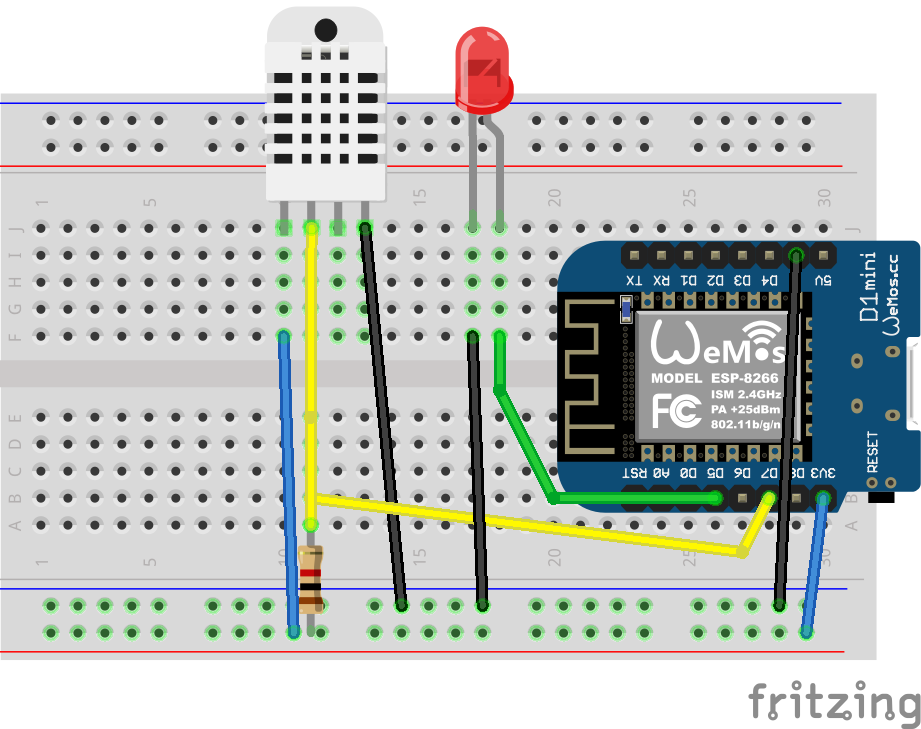Each peripheral on the WemosD1 should be defined in the configMap object, on the device itself. On load(), a configuration JSON is sent to the websocket server. In this case, it's just Node-Red.
It should look something like this, on the device (WemosD1):
[ {
id: "dccbaa81-b2e4-46e4-a2f4-84d398dd86e3",
pin: () => {
I2C1.setup( {
scl: D5,
sda: D4
} );
var lux = require( "BH1750" )
.connect( I2C1 );
lux.start( 1 );
return lux;
},
type: "virtual",
validCmds: [ "read", "readCont", "readContStop" ],
meta: {
metric: "light intensity",
unit: "lux"
}
}, {
id: "828fbaa2-4f56-4cc5-99bf-57dcb5bd85f5",
pin: wemos.D4,
type: "button",
validCmds: [ "on", "off", "getState" ],
meta: {
usage: "Mains Relay"
}
} ]It is simply an array of objects - your peripherals, with a UUID for each. The websocket addresses the peripheral via its UUID.
To send a command from the websocket Server (Node-Red), all that needs to be sent is an array, described below, in msgParse().
function button(device, cmd) {}provides access to a digital pin - can be read or written, toggled, etc. device.pin should be defined as one of the wemos.Dx in the device config.
function dimmer(device, value) {}provides access to pwm features. value would be a duty cycle, e.g. 0-100.
function virtual(device, cmd) {}implements any virtual features, like SPI, I2C, Serial, etc. create your device with pin: function (x) { i2c.setup }
These functions are generic, with the exception of virtual(). They will take an object for device, which should be one of the objects defined in configMap.
These are utility functions ...
function msgParse(msg) {}Parses any messages received from the server via the websocket. Each message should reference a device in the configMap. Message format should look something like:
[ "cmd", { "device": "dccbaa81-b2e4-46e4-a2f4-84d398dd86e3", "cmd": "readCont"}]The device is setup in the const declarations at the beginning of main.js, under the variable named configMap.
The array is a "packet". index 0 defines what type of packet. there are cmd and config packets. this command packet is for a specific device. the wemos can have multiple devices, this ensure the correct device is selected.
For a virtual devices, (i2c, etc.), the cmd: "readCont" should should be a method of the virtual object. For pwm, the cmd: should be a value 0-99, and for button, it should be 'on', 'off'. or 'getState'. Or, define additional methods in the button object (e.g. toggle), and you can call them.
function wsconnect(state) {}Connects to the websocket server. Should only be called after wifi is connected.
Start, connect to hardcoded access point, then connect to hardcoded websocket. Then just wait for a message. When it comes, parse it - parsing it currently consists of reading the light sensor, and now turning on the blue LED on the WemosD1. It writes the light sensor values to the websocket.
On the server side, in my case, Node-Red, setup a websocket and websocket.on('message', function(msg) { console.log(msg); putInDB(msg) }); - something like that. If message comes in, print it, and put it in the DB.
You can import the flow by opening node-red.export, copying the contents, then, in Node-Red, "import->clipboard", paste the JSON, & Deploy.


